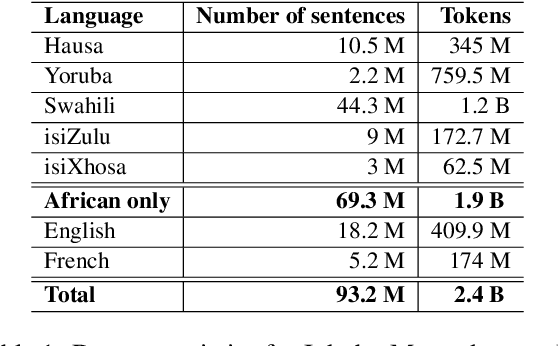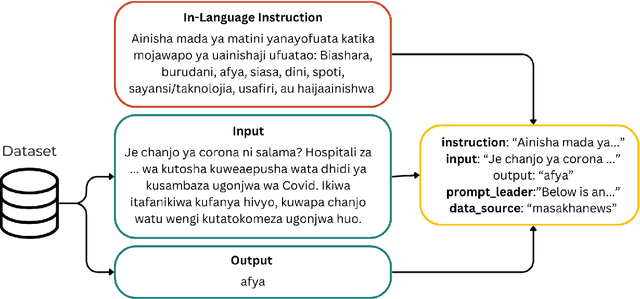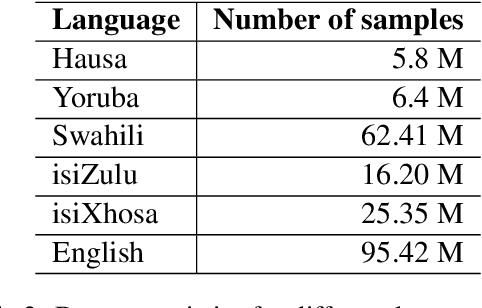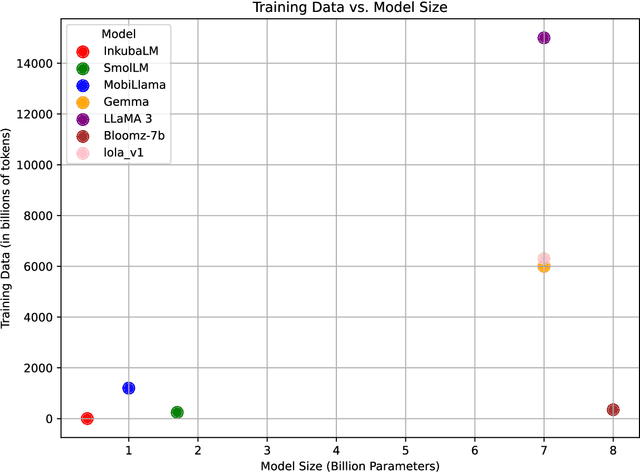Atnafu Lambebo Tonja
The Esethu Framework: Reimagining Sustainable Dataset Governance and Curation for Low-Resource Languages
Feb 21, 2025Abstract:This paper presents the Esethu Framework, a sustainable data curation framework specifically designed to empower local communities and ensure equitable benefit-sharing from their linguistic resources. This framework is supported by the Esethu license, a novel community-centric data license. As a proof of concept, we introduce the Vuk'uzenzele isiXhosa Speech Dataset (ViXSD), an open-source corpus developed under the Esethu Framework and License. The dataset, containing read speech from native isiXhosa speakers enriched with demographic and linguistic metadata, demonstrates how community-driven licensing and curation principles can bridge resource gaps in automatic speech recognition (ASR) for African languages while safeguarding the interests of data creators. We describe the framework guiding dataset development, outline the Esethu license provisions, present the methodology for ViXSD, and present ASR experiments validating ViXSD's usability in building and refining voice-driven applications for isiXhosa.
ProverbEval: Exploring LLM Evaluation Challenges for Low-resource Language Understanding
Nov 07, 2024



Abstract:With the rapid development of evaluation datasets to assess LLMs understanding across a wide range of subjects and domains, identifying a suitable language understanding benchmark has become increasingly challenging. In this work, we explore LLM evaluation challenges for low-resource language understanding and introduce ProverbEval, LLM evaluation benchmark for low-resource languages based on proverbs to focus on low-resource language understanding in culture-specific scenarios. We benchmark various LLMs and explore factors that create variability in the benchmarking process. We observed performance variances of up to 50%, depending on the order in which answer choices were presented in multiple-choice tasks. Native language proverb descriptions significantly improve tasks such as proverb generation, contributing to improved outcomes. Additionally, monolingual evaluations consistently outperformed their cross-lingual counterparts. We argue special attention must be given to the order of choices, choice of prompt language, task variability, and generation tasks when creating LLM evaluation benchmarks.
The Zeno's Paradox of `Low-Resource' Languages
Oct 28, 2024



Abstract:The disparity in the languages commonly studied in Natural Language Processing (NLP) is typically reflected by referring to languages as low vs high-resourced. However, there is limited consensus on what exactly qualifies as a `low-resource language.' To understand how NLP papers define and study `low resource' languages, we qualitatively analyzed 150 papers from the ACL Anthology and popular speech-processing conferences that mention the keyword `low-resource.' Based on our analysis, we show how several interacting axes contribute to `low-resourcedness' of a language and why that makes it difficult to track progress for each individual language. We hope our work (1) elicits explicit definitions of the terminology when it is used in papers and (2) provides grounding for the different axes to consider when connoting a language as low-resource.
InkubaLM: A small language model for low-resource African languages
Sep 03, 2024



Abstract:High-resource language models often fall short in the African context, where there is a critical need for models that are efficient, accessible, and locally relevant, even amidst significant computing and data constraints. This paper introduces InkubaLM, a small language model with 0.4 billion parameters, which achieves performance comparable to models with significantly larger parameter counts and more extensive training data on tasks such as machine translation, question-answering, AfriMMLU, and the AfriXnli task. Notably, InkubaLM outperforms many larger models in sentiment analysis and demonstrates remarkable consistency across multiple languages. This work represents a pivotal advancement in challenging the conventional paradigm that effective language models must rely on substantial resources. Our model and datasets are publicly available at https://huggingface.co/lelapa to encourage research and development on low-resource languages.
CVQA: Culturally-diverse Multilingual Visual Question Answering Benchmark
Jun 10, 2024



Abstract:Visual Question Answering (VQA) is an important task in multimodal AI, and it is often used to test the ability of vision-language models to understand and reason on knowledge present in both visual and textual data. However, most of the current VQA models use datasets that are primarily focused on English and a few major world languages, with images that are typically Western-centric. While recent efforts have tried to increase the number of languages covered on VQA datasets, they still lack diversity in low-resource languages. More importantly, although these datasets often extend their linguistic range via translation or some other approaches, they usually keep images the same, resulting in narrow cultural representation. To address these limitations, we construct CVQA, a new Culturally-diverse multilingual Visual Question Answering benchmark, designed to cover a rich set of languages and cultures, where we engage native speakers and cultural experts in the data collection process. As a result, CVQA includes culturally-driven images and questions from across 28 countries on four continents, covering 26 languages with 11 scripts, providing a total of 9k questions. We then benchmark several Multimodal Large Language Models (MLLMs) on CVQA, and show that the dataset is challenging for the current state-of-the-art models. This benchmark can serve as a probing evaluation suite for assessing the cultural capability and bias of multimodal models and hopefully encourage more research efforts toward increasing cultural awareness and linguistic diversity in this field.
NLP Progress in Indigenous Latin American Languages
Apr 08, 2024



Abstract:The paper focuses on the marginalization of indigenous language communities in the face of rapid technological advancements. We highlight the cultural richness of these languages and the risk they face of being overlooked in the realm of Natural Language Processing (NLP). We aim to bridge the gap between these communities and researchers, emphasizing the need for inclusive technological advancements that respect indigenous community perspectives. We show the NLP progress of indigenous Latin American languages and the survey that covers the status of indigenous languages in Latin America, their representation in NLP, and the challenges and innovations required for their preservation and development. The paper contributes to the current literature in understanding the need and progress of NLP for indigenous communities of Latin America, specifically low-resource and indigenous communities in general.
EthioMT: Parallel Corpus for Low-resource Ethiopian Languages
Mar 28, 2024



Abstract:Recent research in natural language processing (NLP) has achieved impressive performance in tasks such as machine translation (MT), news classification, and question-answering in high-resource languages. However, the performance of MT leaves much to be desired for low-resource languages. This is due to the smaller size of available parallel corpora in these languages, if such corpora are available at all. NLP in Ethiopian languages suffers from the same issues due to the unavailability of publicly accessible datasets for NLP tasks, including MT. To help the research community and foster research for Ethiopian languages, we introduce EthioMT -- a new parallel corpus for 15 languages. We also create a new benchmark by collecting a dataset for better-researched languages in Ethiopia. We evaluate the newly collected corpus and the benchmark dataset for 23 Ethiopian languages using transformer and fine-tuning approaches.
EthioLLM: Multilingual Large Language Models for Ethiopian Languages with Task Evaluation
Mar 26, 2024



Abstract:Large language models (LLMs) have gained popularity recently due to their outstanding performance in various downstream Natural Language Processing (NLP) tasks. However, low-resource languages are still lagging behind current state-of-the-art (SOTA) developments in the field of NLP due to insufficient resources to train LLMs. Ethiopian languages exhibit remarkable linguistic diversity, encompassing a wide array of scripts, and are imbued with profound religious and cultural significance. This paper introduces EthioLLM -- multilingual large language models for five Ethiopian languages (Amharic, Ge'ez, Afan Oromo, Somali, and Tigrinya) and English, and Ethiobenchmark -- a new benchmark dataset for various downstream NLP tasks. We evaluate the performance of these models across five downstream NLP tasks. We open-source our multilingual language models, new benchmark datasets for various downstream tasks, and task-specific fine-tuned language models and discuss the performance of the models. Our dataset and models are available at the https://huggingface.co/EthioNLP repository.
Enhancing Amharic-LLaMA: Integrating Task Specific and Generative Datasets
Feb 12, 2024Abstract:Large language models (LLMs) have received a lot of attention in natural language processing (NLP) research because of their exceptional performance in understanding and generating human languages. However, low-resource languages are left behind due to the unavailability of resources. In this work, we focus on enhancing the LLaMA-2-Amharic model by integrating task-specific and generative datasets to improve language model performance for Amharic. We compile an Amharic instruction fine-tuning dataset and fine-tuned LLaMA-2-Amharic model. The fine-tuned model shows promising results in different NLP tasks. We open-source our dataset creation pipeline, instruction datasets, trained models, and evaluation outputs to promote language-specific studies on these models.
First Attempt at Building Parallel Corpora for Machine Translation of Northeast India's Very Low-Resource Languages
Dec 08, 2023Abstract:This paper presents the creation of initial bilingual corpora for thirteen very low-resource languages of India, all from Northeast India. It also presents the results of initial translation efforts in these languages. It creates the first-ever parallel corpora for these languages and provides initial benchmark neural machine translation results for these languages. We intend to extend these corpora to include a large number of low-resource Indian languages and integrate the effort with our prior work with African and American-Indian languages to create corpora covering a large number of languages from across the world.
 Add to Chrome
Add to Chrome Add to Firefox
Add to Firefox Add to Edge
Add to Edge